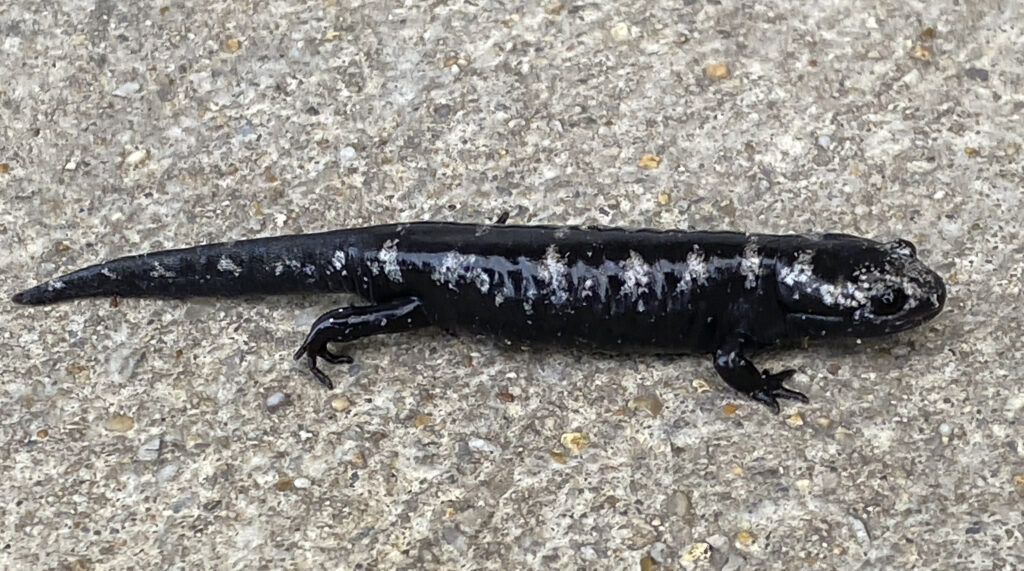Rain and Volunteers Aid Salamander Migration

By Wayne Bierbaum
Springtime is when most animals are looking for love but there are some exceptions—the most obvious being the white-tailed deer. Already the fall rutting season has started and bucks are chasing the does around. But another lesser-known animal also has its courtship in the fall.
Of the 23 salamanders listed by the Maryland Biodiversity Project, only one terrestrial species, the marbled salamander, has a fall reproductive cycle that involves a remarkable migration.
The marbled salamander is a two to four inch forest-dwelling amphibian that hides under logs, in holes, under leaves, or any dark damp area. Moisture is a must because they cannot survive getting dry (desiccation). While they are hidden, they eat whatever small morsel they find: insects, worms, etc.
Even though they are fairly common, their life cycle makes their survival as a species seem tenuous. Marbled salamanders require vernal pools—slight depressions in the ground that collect standing water in the spring but dry out in the summer. Instead of laying and fertilizing eggs in the spring, they walk long distances in the fall and lay the eggs in what will become a vernal pool in the spring.
Thanks to Hurricane Ian, the first heavy rain of fall was forecast for Sept. 30. Jeanette Kazmierczak and her team of citizen scientists who monitor vernal pools at Jug Bay Wetlands Sanctuary predicted that a large marbled salamander migration would occur overnight. A fall rain event would allow the salamanders to travel to the pools without getting dry. Jeanette was worried that the salamanders were in danger of being run over as they crossed roads near the Lothian park. So a group of five vernal pool specialists took flashlights out to the roads and searched for the amphibians on the asphalt to move them out of danger. Most of the moving was just a nudge on the tail to spring them into action but sometimes they needed to be picked up (with very clean hands) and set in the direction of the nearest vernal pool.
Jeanette told me that their group of five moved 300 salamanders off the road in just that one night. Usually the migrations occur over several days but a two-week dry period necessitated this mass movement.
Jeanette says the likely reason for the fall egg laying is because the marbled salamander larva needs a head-start in front of the spring-spawning spotted salamander which will actually feed on their larva. In the late spring, as the vernal pools dry up, the now juvenile marbled salamanders leave the pools and cross through the woods to find a place to live. They become sexually mature at around 18 months old. Once they reach maturity, they will make the fall trek back to their birth spot to reproduce.
Marbled salamanders may seem vulnerable to predators during their march to a vernal pool but they are actually mildly poisonous to eat and are generally left alone. I was curious what would happen if their vernal pool was gone in springtime and found an article that suggested the spotted salamanders would look for another pool. But how would the marbled salamanders find a new one? Perhaps they can smell or taste a difference in the vernal pool ground?
During their studies, the Jug Bay group has found seven different salamander species. They do fall studies on the marbled salamanders and study the pools weekly beginning in February for the very early spring species. Despite being ectothermic (formerly known as cold-blooded), spotted salamanders are known to crawl under snow to reach a vernal pool. Being cold is part of the work when doing vernal pool monitoring. Volunteers for vernal pool monitoring are welcome but realize many weekend and occasional night dedication is requested.
If you have land that has a persistent low spot that is filled with water in the early spring, please don’t fill it in as it may be the lifeline for hundreds of amphibians. A vernal pool can be as small as a few feet across yet full of life.
